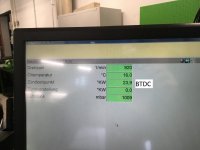So if your timing is reading 24* BTDC at idle, is the vacuum line connected between the distributor and the intake manifold. If the vacuum line is connected then you can be reading what the vacuum advance is adding to your base distributor setting. Typically vacuum advance units will add between 8 and 12 degrees of advance. Without a vacuum line connected to the distributor you would set your initial distributor advance at about 12*. So you see where your full advance comes from, 12 vac, 12 base setting, and about 10 or 12 centrifugal = 34 to 36 degrees total which usually comes all in around 2500 rpms. So what is your total advance in degrees at around 3000rpms and does this include the vacuum canister hooked up? Thanks.

 Hi Guest!
Hi Guest!

 smilie in place of the real @
smilie in place of the real @
 Pretty Please - add it to our Events forum(s) and add to the calendar! >>
Pretty Please - add it to our Events forum(s) and add to the calendar! >> 


